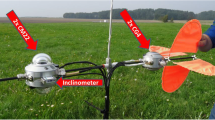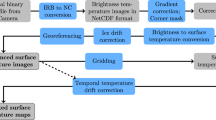Summary
The measurements of surface temperature are prone to important directional anisotropy related to the structure of the canopy and the radiative and energy exchanges inside of it. Directional effects must be taken into account for a number of practical applications such as the correction of large swath satellite data, the assimilation of thermal infrared (TIR) measurements in surface models, the design of future spatial missions… For urban canopies, experimental measurements of TIR directional anisotropy previously performed during summer days over Marseille in the framework of the ESCOMPTE campaign (2001) revealed significant angular surface temperature variations with noticeable hot spot effects whose intensity was related to the canopy structure. The CAPITOUL project (http://medias.cnrs.fr/capitoul/) provided the opportunity to extend these results to other seasons and to nighttime conditions. The experimental setup is based on the use of 2 airborne TIR cameras with different lenses, inclination and resolution, and installed aboard a small aircraft. The flight protocol allowed the retrieval of directional anisotropy in all azimutal directions and in a range of zenith viewing angles between nadir and 62°. Measurements were performed during several intensive operation periods (IOP) in summer (2004 july), autumn (2004 September and October) and winter (2005 February). Only the first results of the 2004 autumn and 2005 winter IOPs are presented in this paper. The results obtained in daytime conditions confirm the systematic hot spot effects observed in previous experiments over cities. The variations found seem to be particularly important in winter when sun elevation is low: for instance they range between −4 and 10 K between oblique and nadir viewing in February. During nighttime conditions, angular variations are much lower (always less than 2 K between nadir and 60° zenithal viewing angle), whichever the azimutal viewing direction.
Similar content being viewed by others
References
AJ Arnfield (2003) ArticleTitleTwo decades of urban climate research: a review of turbulence, exchanges of energy and water, and the urban heat island Int J Climatol 23 IssueID1 1–26 Occurrence Handle10.1002/joc.859
F Becker S-L Li (1995) ArticleTitleSurface temperature and emissivity at various scales: definition, measurement and related problems Remote Sens Rev 12 225–223
C François C Ottlé L Prévot (1997) ArticleTitleAnalytical parameterization of canopy directional emissivity and directional radiance in the thermal infrared. Application on the retrieval of soil and foliage temperatures using two directional measurements Int J Remote Sens 18 IssueID12 2587–2621 Occurrence Handle10.1080/014311697217495
JP Gastellu-Etchegorry E Martin F Gascon (2004) ArticleTitleDART: a 3D model for simulating satellite images and surface radiation budget Int J Remote Sens 25 IssueID1 75–96 Occurrence Handle10.1080/0143116031000115166
CSB Grimmond TR Oke (2002) ArticleTitleTurbulent heat fluxes in urban areas: observations and a Local-Scale Urban Meteorological Parameterization Scheme (LUMPS) J Appl Meteor 41 792–810 Occurrence Handle10.1175/1520-0450(2002)041<0792:THFIUA>2.0.CO;2
Guillevic P, Gastellu-Etchegorry JP, Demarty J, et Prévot L (2003) Thermal infrared radiative transfer within three-dimensional vegetation cover. J Geophys Res Atmos 108(D8); DOI: 10.1029/2002JD002247
J-P Lagouarde H Ballans P Moreau D Guyon D Coraboeuf (2000) ArticleTitleExperimental study of brightness surface temperature angular variations of Maritime Pine (Pinus Pinaster) stands Remote Sens Environ 72 17–34 Occurrence Handle10.1016/S0034-4257(99)00085-1
J-P Lagouarde P Moreau M Irvine J-M Bonnefond J Voogt F Solliec (2004) ArticleTitleAirborne experimental measurements of the angular variations in surface temperature over urban areas: case study of Marseille (France) Remote Sens Environ 93 IssueID4 443–462 Occurrence Handle10.1016/j.rse.2003.12.011
X Li AH Strahler MA Friedl (1999) ArticleTitleA conceptual model for effective directional emissivity from nonisothermal surfaces IEEE Trans Geosci Remote Sens 37 IssueID5 2508–2517 Occurrence Handle10.1109/36.789646
A Martilli A Clappier MW Rotach (2002) ArticleTitleAn urban surface exchange parameterisation for mesoscale models Bound Layer Meteorol 104 IssueID2 261–304 Occurrence Handle10.1023/A:1016099921195
V Masson (2000) ArticleTitleA physically-based scheme for the urban energy budget in meteorological models Bound Layer Meteorol 94 357–397 Occurrence Handle10.1023/A:1002463829265
V Masson CSB Grimmond TR Oke (2002) ArticleTitleEvaluation of the Town Energy Balance (TEB) scheme with direct measurements from dry districts in two cities J Appl Meteorol 41 1011–1026
V Masson L Gomes G Pigeon K Liousse J-P Lagouarde J Voogt J Salmond TR Oke D Legain O Garrouste C Lac O Connan X Briottet S Lachérade P Tulet (2008) ArticleTitleThe Canopy and Aerosol Particles Interactions in Toulouse Urban Layer (CAPITOUL) experiment Meteorol Atmos Phys 102 135–157 Occurrence Handle10.1007/s00703-008-0289-4
JM Norman F Becker (1995) ArticleTitleTerminology in thermal infrared remote sensing of natural surfaces Agric Forest Meteor 77 153–166 Occurrence Handle10.1016/0168-1923(95)02259-Z
TW Owen TN Carlson RR Gillies (1998) ArticleTitleAn assessment of satellite remotely-sensed land cover parameters in quantitatively describing the climatic effect of urbanization Int J Remote Sens 19 IssueID9 1663–1681 Occurrence Handle10.1080/014311698215171
Pigeon G, Legain D, Durand P, Masson V (2006) Anthropogenic heat release in an old European city (Toulouse, France). Int J Climatol (submitted)
M Roth TR Oke WJ Emery (1989) ArticleTitleSatellite-derived urban heat islands from three coastal cities and the utilization of such data in urban climatology Int J Remote Sens 10 IssueID11 1699–1720 Occurrence Handle10.1080/01431168908904002
J-L Roujean (2000) ArticleTitleA parametric hot spot model for optical remote sensing applications Remote Sens Environ 71 197–206 Occurrence Handle10.1016/S0034-4257(99)00080-2
A Soux JA Voogt TR Oke (2004) ArticleTitleA model to calculate what a remote sensor ‘sees’ of an urban surface Bound Layer Meteorol 111 109–132 Occurrence Handle10.1023/B:BOUN.0000010995.62115.46
DR Streukler (2003) ArticleTitleSatellite-measured growth of the urban heat island of Houston, Texas Remote Sens Environ 85 IssueID3 282–289 Occurrence Handle10.1016/S0034-4257(03)00007-5
H Sugawara T Takamura (2006) ArticleTitleLonwave radiation flux from an urban canopy: evaluation via measurements of directional radiometric temperature Remote Sens Environ 104 226–237 Occurrence Handle10.1016/j.rse.2006.01.024
RA Sutherland JF Bartholic (1977) ArticleTitleSignificance of vegetation in interpreting thermal radiation from a terrestrial surface J Appl Meteor 16 IssueID8 759–763 Occurrence Handle10.1175/1520-0450(1977)016<0759:SOVIIT>2.0.CO;2
Vinet J (2000) Contribution à la modélisation thermo-aéraulique du microclimat urbain. Caractérisation de l’impact de l’eau et de la végétation sur les conditions de confort en espaces extérieurs. Thèse, Univ. Nantes, 29 Nov. 2000, 250 pp
JA Voogt CSB Grimmond (2000) ArticleTitleModeling surface sensible heat flux using surface radiative temperatures in a simple urban area J Appl Meteor 39 IssueID10 1679–1699
JA Voogt TR Oke (1997) ArticleTitleComplete urban surface temperature J Appl Meteor 36 1117–1132 Occurrence Handle10.1175/1520-0450(1997)036<1117:CUST>2.0.CO;2
JA Voogt TR Oke (1998) ArticleTitleEffects of urban surface geometry on remotely-sensed surface temperature Int J Remote Sens 19 IssueID5 895–920 Occurrence Handle10.1080/014311698215784
JA Voogt TR Oke (2003) ArticleTitleThermal remote sensing of urban climates Remote Sens Environ 86 370–384 Occurrence Handle10.1016/S0034-4257(03)00079-8
Z Wang Q Peng Y Lu Z Jiang (2001) ArticleTitleA global infrared image synthesis model for large-scale complex urban scene Int J Infrared Millimeter Waves 22 IssueID8 1193–1208 Occurrence Handle10.1023/A:1015067216283
Author information
Authors and Affiliations
Corresponding author
Additional information
Correspondence: Jean-Pierre Lagouarde, INRA, 71 Avenue E. Bourlaux, 33140 Villenave d’Ornon, France
Rights and permissions
About this article
Cite this article
Lagouarde, JP., Irvine, M. Directional anisotropy in thermal infrared measurements over Toulouse city centre during the CAPITOUL measurement campaigns: first results. Meteorol Atmos Phys 102, 173–185 (2008). https://doi.org/10.1007/s00703-008-0325-4
Received:
Accepted:
Published:
Issue Date:
DOI: https://doi.org/10.1007/s00703-008-0325-4




